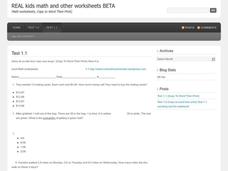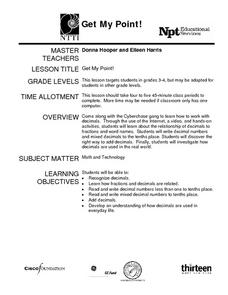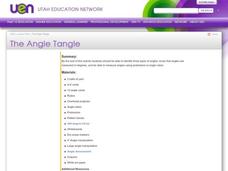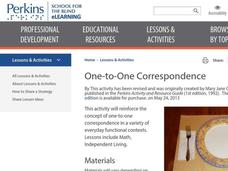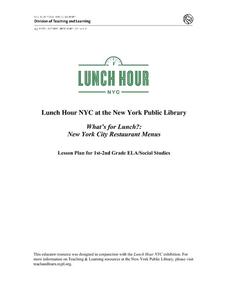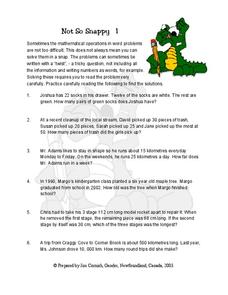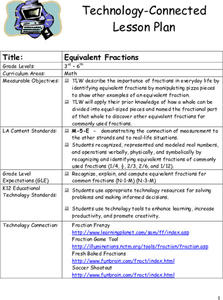Curated OER
Leaf Patterns
First graders explore the existence of patterns in everyday items. In this science and math integrated lesson, 1st graders match leaves with a name word card and organize them into four patterns. This lesson includes a reading of And the...
Curated OER
Fractions and Recipes
Learners, working with their parents in real world situations, calculate to complete three word problems associated with multiplying and dividing fractions.
Curated OER
Estimate Quotients
Fifth graders have to use division to solve problems in everyday situations. This worksheet on estimation and division has students practice these skills using real-life examples. The worksheet is part of the Houghton Mifflin math series...
Curated OER
Primary Counting Skills
Class members drill and practice counting skills from 1 to 20. They count along with a puppet and when the puppet makes a mistake, they correct it. In pairs, they connect cubes to make a train and count the number used. On the last of...
K12 Reader
Basic Geometry Terms
Set your pupils up to start on geometry by teaching them some introductory terminology. Pupils learn the terms by reading a short passage and looking at examples. They then respond to five questions related to the text.
Henrico County Public Schools
Models for Teaching Addition and Subtraction of Integers
Positive and negative numbers are everywhere in the world around us. Whether it's charged particles in atoms, a hot air balloon rising and falling in the sky, or a series of bills and checks being delivered in the mail, this...
Curated OER
Math Word Problems
For this problem solving worksheet, students solve six multiple choice word problems that involve finding probability and identifying monetary amounts.
Illustrative Mathematics
Making Cookies
Hooray for chocolate chip cookies! Ask your mathematicians to triple a chocolate chip cookie recipe and then reduce the recipe by one-fourth. Your class may need two days to complete, tripling the recipe the first day and reducing the...
Curated OER
Get My Point!
Here is one of the better lessons I've come across on how to teach fractions and decimals. This lesson does a great job of showing how these two mathematical representations of numbers are interrelated. Some excellent websites, printable...
Utah Education Network (UEN)
Candies R Us
A box is fun to make, especially when it's a candy box! These activities help to cement understanding of the difference between surface area and volume. Have individuals measure the surface area of their box in two-dimensions before...
Curated OER
Angles
Fourth and fifth graders investigate angles and name them according to the criteria for obtuse, acute, and right angles. They examine a human-made yarn pattern on the floor of their classroom and identify angles, vertices, and types of...
Curated OER
Visualizing Multiplication
Upper graders represent multiplication of a two-digit number by a two-digit number as the area of a rectangle with dimensions of the two factors. They find patterns for the number of different base ten blocks in a rectangle representing...
Perkins School for the Blind
One-to-One Correspondence
Here is an interesting way to build concept understanding regarding one-to-one correspondence. Learners with visual impairments will use an array of everyday objects in context to foster an understanding of what one-to-one correspondence...
New York Public Library
What's for Lunch?: New York City Restaurant Menus
Do you remember the days when a cup of coffee cost five cents? At A.W. Dennett restaurant in 1894, you could buy a five-cent cup of coffee and as well as a five-cent slice of pie to accompany it. The menu from that year is a primary...
Institute of Electrical and Electronics Engineers
Spring Scale Engineering
After examining how a spring scale works, teams work together to design their own general measurement device. Reading material provides background information, but there is no part of the procedure in which learners handle an actual...
Baylor College
Need or Want?
Even as adults it can be hard to distinguish needs from wants. Using pictures of common, everyday items, children make a pocket chart separating the objects they need from those that they want. Discuss their choices, explaining that...
Curated OER
Not So Snappy 1
For this math worksheet, students solve 6 word problems. These problems are not difficult but some have a tricky question, extra information and some numbers written as words.
Curated OER
My Test Book: Multiplication Story Problems
In this math skills learning exercise, students solve 10 multiple choice math problems that require them to multiply using decimals. Students may view the correct answers.
Curated OER
An Introduction to Simple Machines
Students investigate simple machines and their uses in everyday life. In this scientific method instructional activity, students examine physical tools such as wedges, screws, and levers using a "how does it work" approach....
Curated OER
My Test Book: Multiplication and Division
In this online interactive math skills worksheet, students solve 10 multiple choice math problems that require them to multiply and divide with 2-digit numbers. Students may submit their answers to be scored.
Curated OER
Equivalent Fractions
Learners describe importance of fractions in everyday life by identifying equivalent fractions and manipulating pizza pieces to show examples of equivalent fractions, and demonstrate knowledge of how whole can be divided into equal-sized...
Institute of Electrical and Electronics Engineers
Pollution Patrol
Students design and build an outdoor air pollution detector, test their designs, and communicate their results. In this investigative instructional activity students work in teams to design their detectors and use everyday items to...
Curated OER
Terrific Tessellations
Students explore tessellations that are found in nature and everyday objects. They observe the works of M.C. Escher. Students create their own tessellations using pencil and paper.
Curated OER
Measurement Investigations 1
Fifth graders find perimeters, areas, and volumes of everyday objects and state the precision. They work in small groups in order to take measurements, perform calculations, and write a group report about the investigation.
Other popular searches
- Everyday Mathematics
- Math in Everyday Life
- Everyday Math Skills
- Everyday Math Grade 5
- Everyday Math Number Sense
- Everyday Math Fourth Grade
- Everyday Math Grade 2
- Grade 1 Everyday Math
- Everyday Mathematics Arrays
- Algorithms in Everyday Math
- Everyday Math 3
- Everyday Mathematics Review






